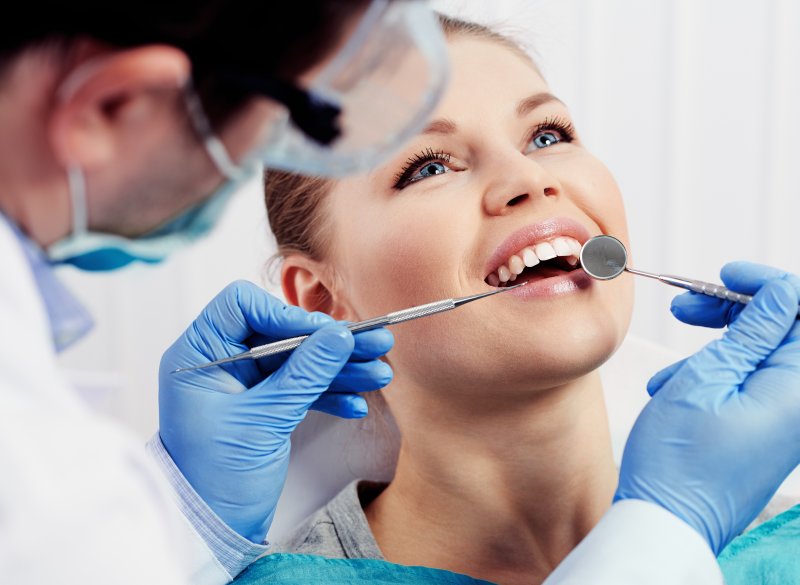Routine Dental Check-ups
Routine dental checkups are vital to good oral hygiene and are the best way to detect problems at their earliest stages. Early detection and treatment saves unnecessary discomfort, time, and money.
The Academy of General Dentistry recommends checkups twice a year. Oral needs change with age and the condition of your teeth and gums. Your Dentist may recommend a checkup schedule that is more or less frequent than twice a year.
What to Expect
Your dental checkup includes:
- A visual exam of your mouth, face, jaw, and neck
- Digital diagnostics, as determined by your Dentist
- A gingival pocket exam
- Professional cleaning of your teeth
- Comprehensive data capture in an electronic dental record
VISUAL EXAMINATION
During a visual exam, your Dentist will use an intraoral camera with sophisticated magnification and lighting to see all surface areas inside your mouth. You will be able to watch the real-time, tooth-by-tooth video exam on your chairside monitor.
Your Dentist looks not only for cracked and decayed teeth, but also for growths and sores on the roof and floor of your mouth, tongue, lips, gums, and the mucous membranes that line your cheeks and gums. Then your Dentist will check the lymph nodes of your head, jaw, and neck for pain, tenderness, and flexibility.
DIGITAL DIAGNOSTICS
- X-Rays: Digital x-rays detect dental problems that cannot be found during a visual exam. We use digital x-rays that provide instant results and emit 90% less radiation. Your Dentist determines how often you need to have x-rays.
- 3-D Imaging: Three-dimensional imaging technology determines the precise position and shape of each tooth. Your Dentist will determine whether the use of this technology is appropriate to aid the development of a dental treatment plan or to follow the progress of your dental treatment.
- Gingival Pocket Exam: Healthy teeth require healthy gums. A gingival pocket exam determines the presence or risk of gum disease.
GINGIVAL POCKET EXAM
Healthy teeth require healthy gums. A gingival pocket exam determines the presence or risk of gum disease.
What to Know
- Each tooth sits inside a gingival pocket of gum tissue. Food debris and plaque naturally collect inside this pocket.
- Daily tooth brushing and flossing remove food debris and plaque from the gingival pocket. If not removed, harmful bacteria penetrate the gumline and deepen the pocket.
- As the depth of a gingival pocket increases, so does the risk of tooth damage and infection that leads to gum disease.
- During your exam, a hand-held instrument is gently placed between gums and teeth (sulcus) to measure the depth of each pocket.
- In its earliest stage, gum disease may be reversible. Since it rarely has symptoms of pain, it is possible to have gum disease and not know it.
PROFESSIONAL CLEANING
Your teeth are cleaned using special instruments to remove plaque from above and below the gumline. Afterwards, your teeth are polished. Tooth polishing makes your teeth look and feel great. It also smoothes tooth surfaces so plaque is less likely to accumulate.
ELECTRONIC DENTAL RECORDS
The records of our patients’ dental checkups, diagnostics, and treatments are kept electronically. Our patients benefit because our Dentist and Specialists have immediate, comprehensive access to medical histories as well as the results of previous and current exams, diagnostics, treatment plans, and progress reports. Electronic dental records improve patient safety and create clinical efficiencies that help reduce patient waiting time before and during appointments.

Good Oral Hygiene
The key to healthy teeth and gums is keeping plaque and food decay from building up in your mouth. Plaque and food decay attract harmful bacteria that cause cavities, gum disease, and persistent bad breath.
Your tongue attracts bacteria, too. During the normal process of eating, tiny fragments of food collect on your tongue. As these fragments decay, bacteria create a filmy white coating on the top of your tongue.
Practice the four-step routine to keep plaque and harmful bacteria from building up in your mouth.
EASY FOUR-STEP ROUTINE
To keep your teeth and gums healthy:
- Brush your teeth and use an antiseptic mouthwash twice daily (after breakfast and before bedtime)
- Use dental floss daily
- Clean your tongue regularly by using a toothbrush or a tongue scraper
- See your dentist for routine dental checkups
BENEFITS OF GOOD HYGIENE
When you practice good oral hygiene, you will:
- Have less plaque to remove during routine dental checkups, so professional cleanings will be faster and more comfortable
- Minimize your need for dental procedures due to tooth decay or gum disease
- Minimize your annual dental budget
- Feel healthier
- Enjoy fresher breath
- Be more confident about your smile
Infants & Small Children
The American Academy of Pediatrics recommends that a child’s first visit to the Dentist be around age three unless any of these dental health risk factors exist:
- Sleeping with a cup or bottle
- Thumb sucking
- Teeth staining
- Down Syndrome
CHILDREN’S ORAL HYGIENE
When your child’s teeth begin to erupt, wipe them daily with a moist washcloth to remove tooth plaque.
As s/he grows more teeth, use a soft child’s toothbrush with non-fluoride toothpaste (like Baby OraGel) until s/he is able to spit out the toothpaste.
When your child is ready to use fluoridated toothpaste, use only a small pea-size amount on the toothbrush. Swallowing too much fluoridated toothpaste can lead to staining of children’s teeth(dental fluorosis).
Kids
It’s never too early to learn how to care for your teeth and gums.
TEACHING GOOD HYGIENE
- Explore Mouthie’s online laboratory to discover the power of a healthy smile

